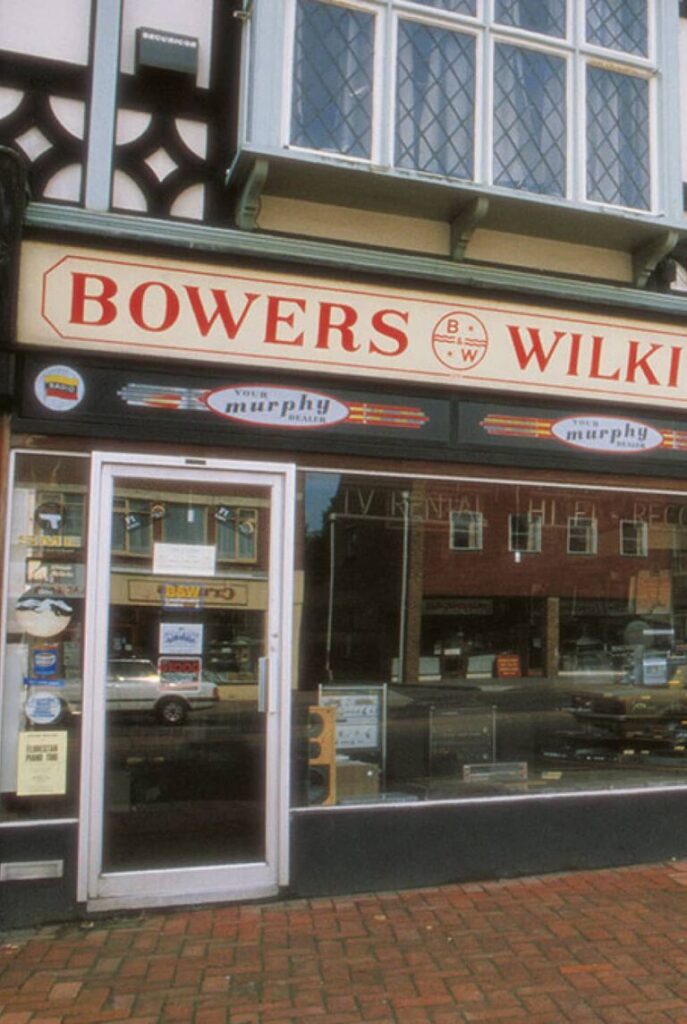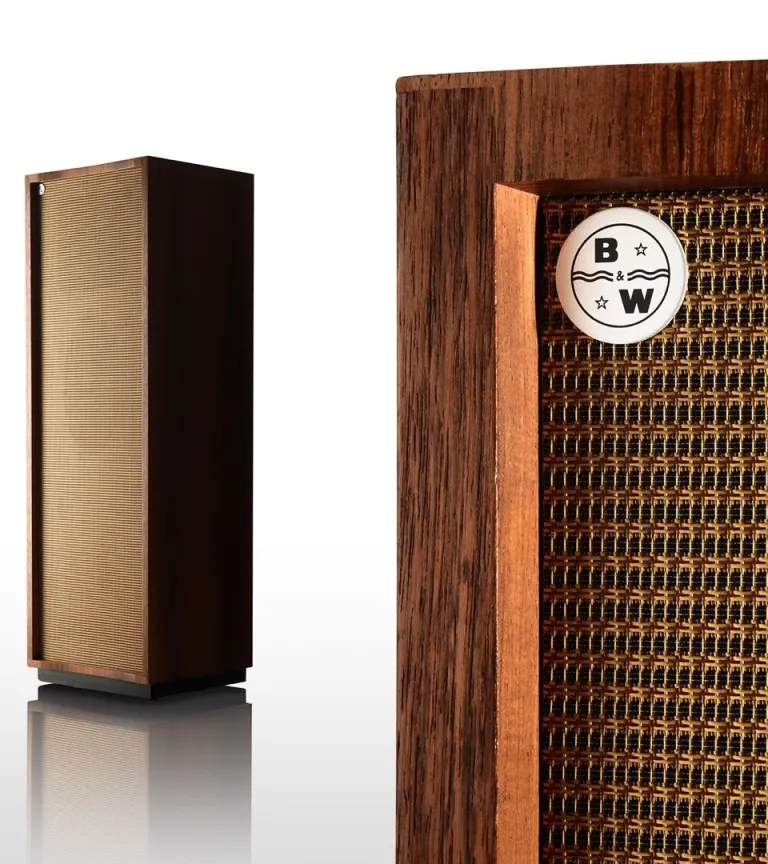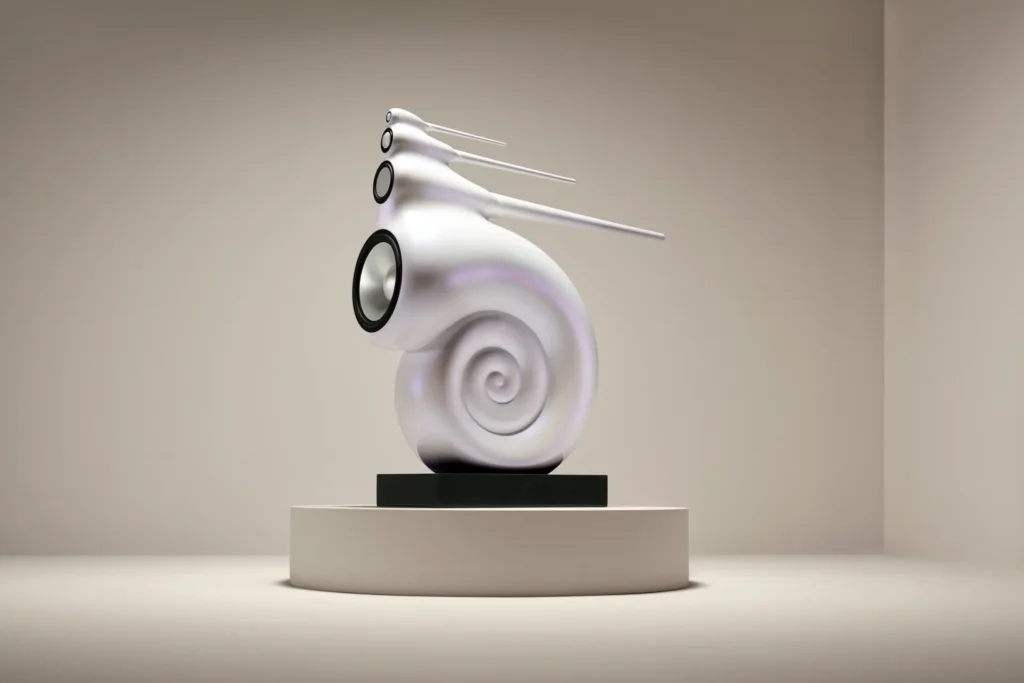Hi-Fi Hall of Fame
Business Inductee
Bowers & Wilkins

Bowers & Wilkins: Introduction
Our next inductee is a business that has been producing world class loudspeakers since 1966: Bowers & Wilkins, or as they are often known, “B&W”.
Founding of Bowers & Wilkins (B&W)
Bowers & Wilkins started as a radio and electronics shop in Worthing, England. The shop was founded after World War II by John Bowers and Roy Wilkins, who met while serving together in the military.

The shop initially sold television sets and audio systems, but John Bowers wasn’t satisfied with the sound quality of available speakers, especially for classical music. He began tinkering with existing designs, building a reputation for his speaker modifications.




About twenty years after opening the store, a turning point came in 1966 when a loyal customer, Miss Knight, passed away and left Bowers a significant sum of money in her will. This windfall allowed him to fully focus on his speaker business, which had been a sideline until then. John Bowers founded the independent loudspeaker business that same year, in 1966.
Bowers & Wilkins (B&W) Iconic Products
Bowers & Wilkins have been building innovative, high quality loudspeakers ever since their founding. Here are a few of their most iconic products.
P1 (1966)
In the early days, John Bowers didn’t have the resources to design and manufacture his own drivers, so he used “off the shelf” speakers from other manufacturers. B&W’s first loudspeaker, the P1, used an EMI woofer and a Celestion tweeter and was released in 1966. It was housed in a tall, floorstanding cabinet. Sales of the new speaker were good, and John Bowers decided to develop more products.


P2 (1967)
Bowers used the profits from the company’s first product to invest in a collection of audio test equipment, the better to understand what would make an ideal loudspeaker. The new model, the P2, was produced in 1967, and each pair was delivered with its own calibration certificate.
The P2 employed a similar cabinet and EMI woofer as the P1, but Bowers replaced the Celestion tweeter with a rather exotic tweeter, the Fane Acoustics “Ionofane” tweeter. The Ionofane was a plasma speaker, which ionized air particles at very high temperatures before modulating them to produce sound. The sound quality was good, however, the ionic modulator had some unpleasant side effects. It produced a strong electromagnetic field which interfered with nearby televisions. The ionized air also smelled funny, some people compared it to rain in a thunderstorm. Thirdly, the ionizer employed a crystal which had to be replaced occasionally. Finally, the tweeter needed to be plugged into an electrical outlet.


Despite all of these shortcomings, the P2 received an enthusiastic response from the music magazine Gramophone, commenting that it was “the approach to perfection that all humans pursue.”
If you would like to read more about the history of plasma, or “massless” speakers, here is a website dedicated to the topic:
DM70 (1969)
John Bowers continued his quest for better loudspeakers, and the next significant design was B&W’s first electrostatic speaker, the DM70, released in 1969.
The DM70 combined a curved electrostatic panel for the treble with a 12 inch EMI woofer. The electrostatic panel was made up of eleven smaller panels arranged in a curved array. The speaker cabinets were made from thick plywood that was steamed and clamped to create a curved shape.
The DM70 was available in two versions: the “Standard”, which edition was finished like a typical speaker of the era, with a wood finish, brown fabric cloth covering the drivers, and four wooden legs. The “Continental” version was quite futuristic looking, available in a wood finish with metal legs, or in a glossy white cabinet perched atop a fluted pedestal stand.



DM6 (1972)
The company continued to grow and invest in the equipment that would allow them to build better speakers. In 1972 they moved into a new factory with an anechoic chamber, advanced test equipment, and a computer to assist in engineering and modelling the speaker designs.
That same year, B&W released the DM6, which incorporated two significant technological advancements: a “phase linear” configuration, and a loudspeaker driver made with a “Kevlar” diaphragm.
Sometimes called the “pregnant penguin” for it’s unique shape, the DM6 was a three way, floorstanding speaker with a stepped front baffle. The baffle and crossover were configured to ensure that all three drivers were “in phase”, in other words, the low, middle, and high frequencies all arrived at the listener’s ear at the same time.

The midrange driver employed a Kevlar cone known for its stiffness and good damping properties. Kevlar is the same material used to make bullet proof vests for police and military personnel.

801 (1979)
In the mid 1970s, John Bowers gave his engineers a mandate to create a “no compromise” flagship speaker for enthusiasts and professional users. The result of that project was the model 801, released in 1979.
It was a three way speaker, where each of the three drivers had it’s own dedicated cabinet to prevent interference. Designers used a new technology, laser interferometry, to measure the movements of the drivers. A novel mixture of fiberglass and concrete was used to make the cabinets to minimize any vibrations or resonances.

The new speaker was a superb performer, and was adopted as a studio monitor by professional studios such as EMI, Decca, Abbey Road, Skywalker Sound, and Deutsche Grammophon.

The 801 has evolved over the years into the “800” series of B&W speakers. The 800 series employs cutting edge technologies and luxurious materials, deliver pristine sound, and are a favorite among professional recording studios and discerning listeners.

Nautilus (1993)
In the 1980s, John Bowers started another quest for the ideal speaker design. This time, his goal was to entirely eliminate any negative effects from the cabinet itself. The project would ultimately be known as the Nautilus.
Sadly, in December 1987, John Bowers passed away before he could complete the Nautilus project. Fortunately, the new B&W leadership decided to continue the project, and the first Nautilus system was launched in 1993. It was a true engineering and manufacturing marvel. Its distinctive, spiraling design was beautiful, inspired by the sea creature of the same name. The cabinet also minimized internal resonances for unmatched sound clarity. The Nautilus is a highly sought speaker for audiophiles, and it’s unique design has earned it a place on museums’ permanent collections.

The Nautilus cabinet is crafted with high quality reinforced ABS plastic for a rigid and acoustically inert enclosure. It’s a four way speaker system with separate drivers for different frequency ranges: a woofer for deep bass, a mid-range driver, an upper midrange driver, and a tweeter for high frequencies. Each driver utilizes high-quality materials such as aluminum for minimal distortion.

Each Nautilus speaker is meticulously hand-assembled by skilled technicians, ensuring the highest level of quality and performance. In 2023, B&W released a special 30th anniversary edition of the Nautilus, and the speaker remains in production today, more than 30 years after it’s initial launch.

PV1 Subwoofer (2004)
The B&W PV1 subwoofer is a high end subwoofer known for its unique design and clear, tight bass. The PV1 features a curved, aluminum enclosure, a design which minimizes cabinet resonance, resulting in cleaner sound because the drivers focus their energy on producing bass instead of vibrating the cabinet itself.

The PV1 employs a pair of 20cm woofers in an opposed, in-phase configuration. This means the drivers move inwards and outwards together, cancelling out cabinet vibrations further and producing accurate bass. It is equipped with a powerful 500 watt “Class D” amplifier. The PV1’s aluminum enclosure acts as a heatsink for the amplifier.
Zeppelin (2007)
Apple introduced their first “iPod” portable music player in 2001 and it was a game changer for the industry. It had an elegant user interface and straightforward integration with the Apple “iTunes” online music store, which made it easy for people to use. Apple sold millions of iPod players over the next few years, and many of those users wanted an easy way to play that music through speakers.

To meet that need, B&W decided to create an iPod “dock” with built in amplifiers and speakers. Their goal was an easy to use device with exceptional sound quality and distinctive aesthetics. The result was the B&W “Zeppelin”, first released in 2007. With its distinctive design, it required a fair amount of desk space but it rewarded the user with a detailed, spacious sound. The Zeppelin was equipped with an Apple connector so the user just had to plug the iPod in. It sounded great, looked great, and got a lot of attention and positive reviews for B&W.

Like many other B&W products, the Zeppelin has evolved over the years. B&W released the Zeppelin “Air” with wireless (Apple AirPlay) connectivity in 2011 and the Zeppelin “Wireless” (supporting a range of wireless streaming services) in 2015.

600 “S3” Loudspeaker Range (2023)
B&W first introduced the “600” series of loudspeakers way back in 1991. The 600 series is the entry level range in the B&W lineup, just below the more upscale 700 and 800 series. The 600 series has been hugely popular, and the company has been constantly refining the line with new technologies and aesthetics.
In 2023, 32 years after that initial launch, B&W released the 8th generation of the 600 series. The latest generation is called the “S3” series and the lineup includes small bookshelf speakers, a center channel speaker, and one floorstanding speaker.

The new speakers are equipped with some of B&W’s latest technologies, including titanium tweeter, “Continuum” bass/midrange driver, and “Flowport” bass reflex port. For the more discerning listener, they are equipped with bi-wired inputs to allow the use of separate amplifiers for each band.
Bowers & Wilkins: Impact on Hi-Fi
Bowers & Wilkins have had a significant impact on the Hi-Fi industry in several ways.
First, the company has always emphasized accuracy and innovation in their products. They’ve achieved this through continuous research and development, pioneering new materials and techniques for their speaker components. This focus on quality has helped set the bar high for what audiophiles expect from Hi-Fi speakers. They have pioneered the use of ionic and electrostatic tweeters, “Nautilus” and matrix cabinets, Kevlar and diamond diaphragms, and computerized speaker design.
Second, B&W make sure that their speakers are as beautiful to look at as they are to listen to. From that first P1 speaker to the latest 800 series, B&W speakers are always attractive additions to the home.

Third, many B&W speakers are affordable; they aren’t just for the wealthy audiophile. They offer a range of speaker lines at various price points, making it possible for more people to experience high-quality sound at home. Many of their technological innovations “trickle down” over time to their entry level products.
B&O has consistently prioritized delivering high-quality sound reproduction. Their commitment to audio excellence has driven them to develop advanced technologies and techniques to enhance the listening experience. B&O has continually refined its engineering and audio processing to achieve faithful and immersive sound reproduction.
Bowers & Wilkins: Still Thriving
After more than fifty years in business, Bowers & Wilkins are still thriving. The company has gone through a number of ownership and management changes over the year, but the original culture created by John Bowers is still intact.
The company continues to build “classic” passive speakers for home Hi-Fi systems and professional settings, but they have expanded the product line to include powered speakers, headphones, home theatre systems, automotive, and marine systems.
If you’d like to read more about the company’s products, they have a number of websites that you can visit; here are a few suggestions:
Induction to the Hi-Fi Hall of Fame
Bowers & Wilkins is one of Hi-Fi’s most iconic loudspeaker manufacturers. Their speakers are sold all over the world, and they have earned a reputation for high quality, accurate, beautiful loudspeakers. For their many technical advancements. their commitment to quality and aesthetics, and more than fifty years producing superb loudspeakers, Bowers & Wilkins is inducted into the Hi-Fi Hall of Fame.
